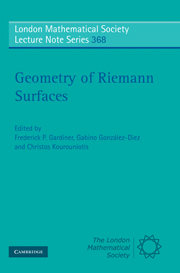Book contents
- Frontmatter
- Contents
- Preface
- Foreword
- Semisimple actions of mapping class groups on CAT(0) spaces
- A survey of research inspired by Harvey's theorem on cyclic groups of automorphisms
- Algorithms for simple closed geodesics
- Matings in holomorphic dynamics
- Equisymmetric strata of the singular locus of the moduli space of Riemann surfaces of genus 4
- Diffeomorphisms and automorphisms of compact hyperbolic 2-orbifolds
- Holomorphic motions and related topics
- Cutting sequences and palindromes
- On a Schottky problem for the singular locus of A5
- Non-special divisors supported on the branch set of a p-gonal Riemann surface
- A note on the lifting of automorphisms
- Simple closed geodesics of equal length on a torus
- On extensions of holomorphic motions—a survey
- Complex hyperbolic quasi-Fuchsian groups
- Geometry of optimal trajectories
- Actions of fractional Dehn twists on moduli spaces
Semisimple actions of mapping class groups on CAT(0) spaces
Published online by Cambridge University Press: 05 May 2013
- Frontmatter
- Contents
- Preface
- Foreword
- Semisimple actions of mapping class groups on CAT(0) spaces
- A survey of research inspired by Harvey's theorem on cyclic groups of automorphisms
- Algorithms for simple closed geodesics
- Matings in holomorphic dynamics
- Equisymmetric strata of the singular locus of the moduli space of Riemann surfaces of genus 4
- Diffeomorphisms and automorphisms of compact hyperbolic 2-orbifolds
- Holomorphic motions and related topics
- Cutting sequences and palindromes
- On a Schottky problem for the singular locus of A5
- Non-special divisors supported on the branch set of a p-gonal Riemann surface
- A note on the lifting of automorphisms
- Simple closed geodesics of equal length on a torus
- On extensions of holomorphic motions—a survey
- Complex hyperbolic quasi-Fuchsian groups
- Geometry of optimal trajectories
- Actions of fractional Dehn twists on moduli spaces
Summary
Abstract
Let Σ be an orientable surface of finite type and let Mod(Σ) be its mapping class group. We consider actions of Mod(Σ) by semisimple isometries on complete CAT(0) spaces. If the genus of Σ is at least 3, then in any such action all Dehn twists act as elliptic isometries. The action of Mod(Σ) on the completion of Teichmüller space with the Weil-Petersson metric shows that there are interesting actions of this type. Whenever the mapping class group of a closed orientable surface of genus g acts by semisimple isometries on a complete CAT(0) space of dimension less than g it must fix a point. The mapping class group of a closed surface of genus 2 acts properly by semisimple isometries on a complete CAT(0) space of dimension 18.
Introduction
This article concerns actions of mapping class groups by isometries on complete CAT(0) spaces. It records the contents of the lecture that I gave at Bill Harvey's 65th birthday conference at Anogia, Crete in July 2007.
A CAT(0) space is a geodesic metric space in which each geodesic triangle is no fatter than a triangle in the Euclidean plane that has the same edge lengths (see Definition 2.1). Classical examples include complete 1-connected Riemannian manifolds with non-positive sectional curvature and metric trees. The isometries of a CAT(0) space X divide naturally into two classes: the semisimple isometries are those for which there exists x0 ∈ X such that d(γ·x0, x0)= |γ| where |γ| := inf{d(γ·y, y) | y ∈ X}; the remaining isometries are said to be parabolic. Semisimple isometries are further divided into hyperbolics, for which |γ| > 0, and elliptics, which have fixed points.
Information
- Type
- Chapter
- Information
- Geometry of Riemann Surfaces , pp. 1 - 14Publisher: Cambridge University PressPrint publication year: 2010
Accessibility standard: Unknown
Why this information is here
This section outlines the accessibility features of this content - including support for screen readers, full keyboard navigation and high-contrast display options. This may not be relevant for you.Accessibility Information
- 14
- Cited by
